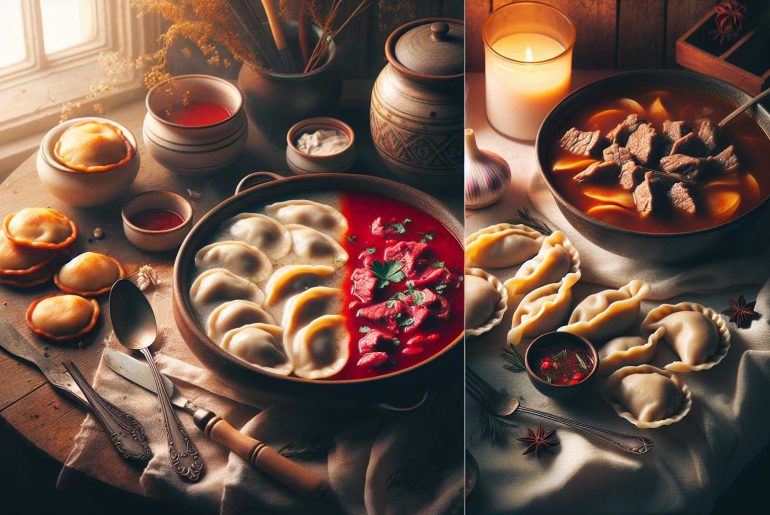
Exploring the culinary worlds of Eastern Europe, especially figuring out the differences between Polish food and Russian cuisine, is both interesting and a bit tricky. Although both types of food come from places with cold weather, which makes for hearty meals, they’re quite different because of their history, key ingredients, and famous dishes.
For example, Polish food often uses subtle spices and seasonings, while Russian meals tend to have stronger flavors. Also, looking at holiday foods can really show you how different these two cuisines are. It’s fascinating to see how two places so close to each other can have such unique food and traditions.
Historical Influences
Eastern Europe’s history has significantly shaped Polish and Russian cuisines, making them unique. This area has experienced many invasions and cultural exchanges, influencing its food traditions. For example, Polish food focuses on meats and hearty meals, reflecting the country’s agricultural background and historical warrior culture. This cuisine has evolved, embracing flavors from neighboring countries.
On the other hand, Russian food shows a wider range of influences, including Asian flavors, due to Russia’s vast territory that stretched from Europe to Asia. This mix is on top of its Slavic origins. Thus, Polish and Russian dishes are more than just a set of recipes; they’re deeply rooted in each country’s history, society, and economy. They tell stories of overcoming challenges, adapting to new circumstances, and blending different cultures.
For instance, in Poland, you might enjoy pierogi, dumplings filled with a variety of ingredients, showcasing the country’s ability to blend external culinary influences with its own traditions. In Russia, borscht, a hearty beet soup, illustrates the blend of Slavic and Asian influences, adapted across different regions of the vast country.
Both cuisines, therefore, offer a window into the past, presenting dishes that have survived and evolved through time. They highlight the importance of food in understanding cultural identity and the impact of historical events on daily life. Whether you’re savoring a plate of pierogi or enjoying a bowl of borscht, you’re experiencing a piece of history that has been passed down through generations.
Staple Ingredients
Exploring the historical roots of Polish and Russian cuisines reveals the key ingredients that define these rich culinary traditions. In Poland, the kitchen buzzes with the use of potatoes, cabbage, and dairy products like sour cream and cheese. Meat, especially pork, is a staple, reflecting the country’s love for hearty meals. Root vegetables and mushrooms are also essential, showcasing Poland’s agricultural and forest bounty.
On the other side, Russian cuisine leans heavily on grains. Rye, wheat, barley, and buckwheat form the foundation of countless breads and porridges that have fed generations. Beetroot, the star in many famous Russian dishes, and a wide variety of fish, from Russia’s vast rivers and seas, are indispensable. This emphasis on different staple ingredients underlines how climate, geography, and history have uniquely molded each cuisine.
Let’s break it down further. Think of Polish dishes like pierogi or bigos, where you can taste the earthy flavors of potatoes and cabbage, enriched with the creaminess of dairy and the savory depth of pork. These ingredients not only tell the story of Poland’s culinary preferences but also its farming practices and cultural traditions.
In Russia, imagine sitting down to a meal of borscht followed by a hearty serving of kasha. Here, the sour tang of beetroot soup meets the nutty, comforting warmth of buckwheat porridge. These flavors don’t just fill the plate; they narrate Russia’s reliance on its grain crops and the creativity of its people in turning simple ingredients into soul-warming meals.
Understanding these cuisines goes beyond the ingredients. It’s about recognizing the connection between the land, its history, and how people have adapted to their environment to create dishes that are loved worldwide. So, the next time you enjoy a Polish or Russian meal, remember the stories and traditions baked into every bite.
Signature Dishes
Exploring signature dishes takes us right into the heart of Polish and Russian food traditions. These dishes are more than just food; they tell stories about the countries’ histories and cultures. In Poland, Pierogi stands out as a must-try dish. These dumplings come filled with various ingredients, showing how Polish cooking is all about using what’s available and making it delicious. On the other side, Russia is famous for its Borsch, a beetroot soup that’s both nutritious and warming. This soup highlights how Russian cooks make the most of local ingredients to create meals that bring people together.
Pierogi and Borsch might seem very different, but they both represent their cultures’ ability to adapt and thrive. For example, Pierogi can be filled with meat, vegetables, or even fruit, which means they can be enjoyed by just about anyone, regardless of dietary preferences. Borsch, meanwhile, often comes with a dollop of sour cream and a side of bread, making it a comforting meal during Russia’s cold winters.
These dishes do more than fill you up; they give you a taste of Polish and Russian life. They show the importance of family meals and the joy of sharing food with others. Whether you’re eating Pierogi at a family gathering or enjoying Borsch at a local restaurant, you’re taking part in a tradition that goes back generations.
Seasoning and Spices
Polish and Russian cuisines offer a fascinating glimpse into the ways seasoning and spices can define the eating experience. In Poland, the food is known for its comforting qualities, often achieved through the use of specific seasonings like marjoram, dill, caraway seeds, and garlic. These ingredients not only add depth to popular dishes like pierogi and bigos but also give Polish cuisine its distinctive taste. For example, marjoram adds a slightly sweet, citrusy flavor that complements the savory fillings of pierogi, while caraway seeds bring a nutty, bittersweet sharpness to bigos, enhancing its complexity.
On the other hand, Russian dishes tend to embrace a broader spectrum of flavors, favoring the boldness of bay leaves, mustard seeds, horseradish, and peppercorns. These spices are particularly effective in soups and stews, where they contribute layers of flavor that evolve with each spoonful. Mustard seeds, for instance, add a spicy kick to broths, while horseradish offers a pungent heat that invigorates traditional Russian sauces.
The difference in seasoning between Polish and Russian cuisines not only reflects their respective cultural and geographical backgrounds but also showcases the unique culinary identity of each country. For those interested in exploring these flavors at home, starting with authentic recipes is key. Incorporating quality spices from reputable sources can make a significant difference in achieving the authentic taste of Polish and Russian dishes. Brands like Penzeys Spices or Spice House offer a wide range of high-quality options that can help home cooks recreate these traditional flavors accurately.
Understanding the role of seasoning in Polish and Russian foods enriches our appreciation of their culinary traditions. It’s fascinating how something as simple as the choice of spices can tell us so much about a culture’s history and its approach to cooking. Whether you’re a seasoned chef or a curious foodie, experimenting with these flavors can open up a whole new world of culinary discovery.
Festive Traditions
Polish and Russian festive traditions offer a fascinating glimpse into how each culture celebrates important occasions, especially when it comes to food. Let’s dive into some of these traditions to understand their cultural and historical significance.
In Poland, Christmas Eve is a special day known as Wigilia. This celebration is unique because it features a meal without meat. Instead, the table is filled with dishes like carp, pierogi (filled dumplings), and barszcz (beet soup). These choices aren’t random. They’re chosen to represent abundance and hope. Carp is a symbol of luck and prosperity, pierogi bring togetherness, and barszcz, with its vibrant color, adds to the festive spirit. It’s a thoughtful way to reflect on the year’s blessings and to look forward to the future.
On the other hand, Russia’s New Year celebrations are famous for their ‘Zakuski’ table. This isn’t just any meal; it’s a feast of appetizers meant to bring families together and to symbolize wealth and happiness for the year ahead. The table might include luxurious caviar, tangy pickled herring, and the hearty Olivier salad, which is similar to a potato salad but with a Russian twist. Each dish has a story or a wish behind it, making the meal even more meaningful.
These traditions do more than just fill stomachs; they strengthen bonds, foster a sense of community, and connect people to their heritage. They’re not just about the food but what the food represents. For instance, sharing a dish of pierogi can be a way to remember ancestors and to pass down family stories and customs. Similarly, gathering around a Zakuski table can reinforce the importance of family unity and the joy of coming together.
What’s truly remarkable is how these traditions have been kept alive through generations. They are a testament to the power of food in preserving cultural identity and history. It’s not just about following a recipe; it’s about keeping a legacy alive. That’s something worth celebrating, don’t you think?
Conclusion
To sum it up, when we look closely at Polish and Russian food, we can see they’re quite different from each other, even though the two countries are neighbors and have been through some similar historical events. These differences come from what foods are popular in each place, the kinds of dishes they’re known for, the seasonings they use, and how they celebrate with food.
It’s really interesting to see how each country’s food tells a story about its people, their history, and what’s important to them. It’s a cool reminder of how food is more than just something to eat – it’s a way to show who we are and where we come from.







Comments are closed.